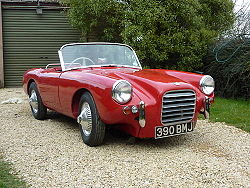Berkeley B95
| Berkeley | |
|---|---|
|
Berkeley B95 Roadster
|
|
| B95 / B105 | |
| Production period: | 1959-1960 |
| Class : | Sports car |
| Body versions : | Roadster |
| Engines: |
Petrol engines : 0.69 liters (29–37 kW) |
| Length: | 3124-3188 mm |
| Width: | 1270 mm |
| Height: | 1143 mm |
| Wheelbase : | 1778 mm |
| Empty weight : | 368 kg |
| Previous model | B90 Twosome |
The Berkeley B95 is a mini sports car that the British manufacturer Berkeley Cars built from March 1959 to December 1960 as the successor to the B90 Twosome . In addition to the B95, there was also the more powerful Berkeley B105 version .
The B95 and B105 were driven by an air-cooled two - cylinder four-stroke in - line engine with a displacement of 692 cm³ (bore × stroke = 70 mm × 90 mm). The Super Meteor type overhead engines were supplied by Royal Enfield . In the B95, the engine was 7.25: 1 compressed and gave 40 bhp (29 kW) at 5500 rpm. from. The B105, which was also presented at the 1959 Geneva Motor Show , had an 8: 1 engine compression and developed 50 bhp (37 kW) at 6250 rpm. The engine power was passed on to the front wheels via a four-speed gearbox and a duplex chain. As with the predecessor, the front and rear wheels were individually suspended and had coil springs
The engines had a Lucas "Bendix" starter and a separate alternator .
The body of the car also corresponded to the previous model and was made of GRP in three sections (floor pan, front, rear) . What had changed compared to the predecessor was the front, which was now higher to offer space for the larger engine, featured a larger grille and headlights without the additional, sloping covers. The B105 was 64 mm longer than the B95 with the same wheelbase and width.
The B105 reached a top speed of 160 km / h, so it was a "hundred mile car".
For the prototype , a B90 Twosome with the frame number 638 was used, the body of which was reinforced and the front, like the later series models, was redesigned to accommodate the larger engine. In mid-February 1959, this car was tested by the Royal Enfield factory for two weeks. During this time he completed a test program of 800 km on normal roads and 1,600 km of tests at the Motor Industry Research Association (MIRA). When the B95 was unveiled in March 1959, Berkeley test drivers had reeled another 4,000 km on normal roads and circuits. In order to improve the reputation, which had been scratched by the not very stable two-stroke engines of the predecessor, the company announced that there had been no unplanned stops during the test phase due to mechanical problems and that they intended to continue the tests until a total distance of 24,000 km is unwound.
When it was first introduced, a B95 cost £ 659. The first B95 was approved for road use in late March 1959. The first B105 was delivered about a month later. Of the two models together, about 175 copies were made, of which 15–20 were exported. At the end of 1960 production was stopped without a successor; it is the manufacturer's last production model.
Individual evidence
- ↑ a b c d e f g David Culshaw, Peter Horrobin: The Complete Catalog of British Cars 1895-1975 . Veloce Publishing, Dorchester 1997. ISBN 1-874105-93-6 . P. 85.
- ^ David Culshaw, Peter Horrobin: Complete Catalog of British Cars . Macmillan, London 1974. ISBN 0-333-16689-2 .
- ^ G. Robson: A – Z of British Cars 1945–1980 . Herridge Books, Devon 2006. ISBN 0-9541063-9-3 .

